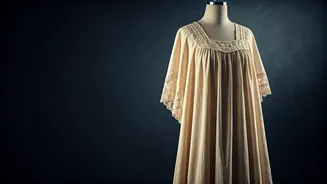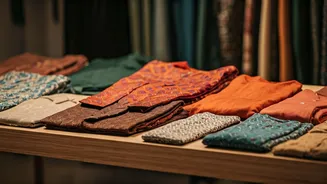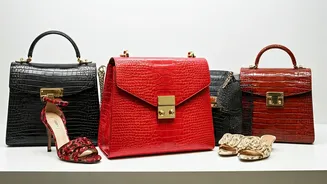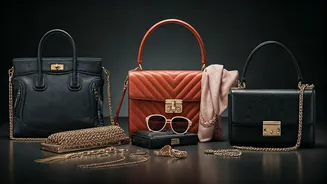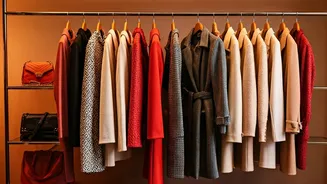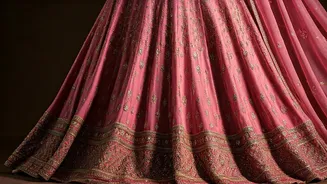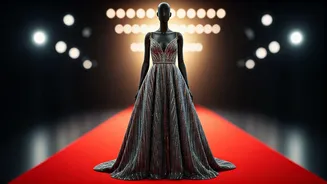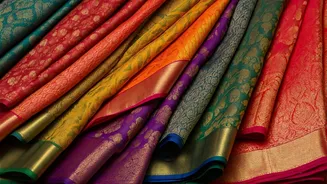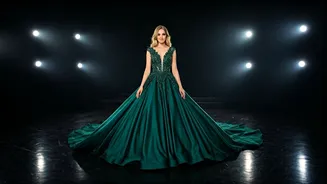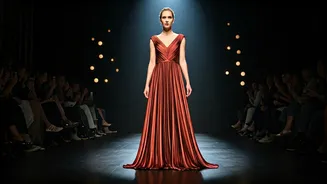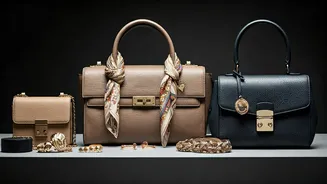Ancient Roots and Beginnings
Fashion, in its earliest forms, emerged from fundamental necessities like protection from the elements. However, clothing quickly transcended its practical
origins, evolving into a means of self-expression and social signaling. Ancient civilizations like Egypt and Greece showcased early fashion statements through elaborate garments and accessories. In Egypt, linen robes and jewelry indicated status, while in Greece, draped tunics and cloaks reflected cultural values. These initial expressions laid the groundwork for the future of fashion. Materials available determined the look. Textiles such as wool, cotton and silk set the tone for ancient designs, marking the dawn of design as a deliberate act of culture.
The Renaissance and Beyond
The Renaissance marked a pivotal transformation in fashion. As art, science, and philosophy flourished, clothing reflected the era's focus on beauty, individualism, and grandeur. Rich fabrics, elaborate embellishments, and tailored silhouettes became hallmarks. The nobility's garments were a show of wealth and power, while evolving trade routes introduced exotic materials. The corset became a defining piece for women's fashions, symbolizing the desired idealized form. Meanwhile, men's attire saw the rise of intricate embroidery and opulent textiles. The Renaissance laid a foundation for fashion to become a widespread industry, which was sustained throughout the early modern period.
18th-Century Elegance Unveiled
The 18th century witnessed a shift towards more refined and elegant styles, particularly during the Rococo period. Silhouettes became softer, with intricate details in fabrics like silk and lace. Women's dresses, such as the elaborate panniers, emphasized the waist and hips. Men's fashion incorporated tailored coats, waistcoats, and breeches, reflecting the era's focus on etiquette and formality. The court of Versailles played a crucial role in dictating fashion trends, with styles spreading throughout Europe. Accessories like wigs, hats, and fans complemented the attire, creating a visually stunning spectacle that defined the 18th century's fashion trends.
Victorian Era's Refinement
The Victorian era's fashion emphasized modesty and social decorum. Women's clothing featured high necklines, long sleeves, and full skirts, reflecting the era's conservative values. Corsets maintained importance, contributing to a restricted silhouette. As the century progressed, silhouettes transitioned, with a more pronounced bustle. Men's fashion incorporated tailored suits, frock coats, and top hats, signaling professionalism and respectability. Fabrics like velvet, wool, and silk were popular, reflecting the Victorian era's industrial advancements and the rise of the middle class. The era also saw the rise of mass production, which democratized fashion and allowed more people to access stylish clothing.
20th Century's Revolution
The 20th century transformed the landscape of fashion. The early 1900s embraced the simplicity of the flapper style, which was a rejection of Victorian constraints. Designers like Coco Chanel challenged conventional ideas, introducing comfortable and practical designs. The World Wars influenced clothing's function, with practical, utilitarian styles becoming popular. Post-war fashion saw the emergence of the New Look by Christian Dior, which emphasized a feminine silhouette, marking a return to elegance. The 1960s brought youth-driven trends, including mini skirts and mod styles. The 1970s and 1980s saw a mix of disco, punk, and power dressing, with fashion becoming a vehicle for self-expression. High fashion and ready-to-wear both thrived in the era.
Sustainability in Focus
Sustainability is a defining trend in today's fashion. Consumers are increasingly aware of the industry's environmental and social impacts, including fast fashion's ecological footprint and labor practices. Brands are responding by adopting sustainable practices like using organic materials, reducing waste, and promoting ethical sourcing. Upcycling and vintage clothing are becoming mainstream, offering alternatives to rapid consumption. The industry is exploring innovative technologies, like lab-grown materials and circular design models. The shift towards sustainability is reshaping the industry, focusing on quality, durability, and responsible practices. Consumers and brands are collaborating to build a more ethical and ecologically sound fashion ecosystem.
Digital Fashion's Arrival
Digital technologies are dramatically impacting fashion. Virtual fashion, where garments exist only in digital form, is gaining traction. Designers are using 3D modeling and augmented reality to showcase collections and create immersive shopping experiences. Social media platforms, such as Instagram and TikTok, are driving trends, with influencers shaping consumer preferences. E-commerce is rapidly evolving, with personalized shopping experiences and virtual try-on technologies becoming commonplace. Digital fashion is not only transforming how fashion is designed and consumed, but also offering avenues for artistic expression and collaboration. As technology advances, digital fashion's role will likely grow, bridging the physical and virtual worlds.
